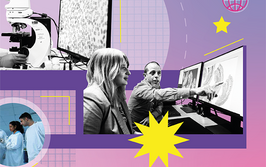Reliable Synthesis Theory: A Call for Future Leadership
How can pathology educators produce resilience in the training environment?
Kristine McCluskey | | 6 min read | Learning

There are many ways for educators to act as leaders. There’s the traditional route in which they pass on expertise to their students – or there is the symbolic way in which people lead by good example or by instilling confidence in those around them. It may surprise you to learn that, in my work, I focus on the latter – why? Because finding leaders for pathology residents and pathologists’ assistant students is crucial to set the standard for future professionals. For these future practitioners, effective training relies on the interactions between leaders and learners within an academic institution’s culture.
Through the years, the concept of “culture” has evolved. In the past, culture was simply an organization’s climate or the interactions between members in their physical environment – including combating external stressors, developing customs and traditions, and embedding skills. However, we now see culture as an increasingly complex organism. Due to outside factors affecting pathology’s culture, educators must adapt and overcome obstacles with resilience by demonstrating valid, reliable behavior. This is a key proposal to ensure optimal patient care.
I have noticed a common thread across the works of many important figures and researchers: the image of the reliable leader. Vulnerability expert Brené Brown, organizational culturist Edgar Schein, John Kotter, Karl Weicke, Kathleen Sutcliffe – all these people cross disciplines and fields, but the reliable leader appears in all their works. For them, the reliable leader is trustworthy, deflects errors and stagnation, prevents loss of communication, and drives experiential learning and change. Using these experts’ suggestions, we can construct a “reliable synthesis theory” for educational leaders to address the training deficiencies discovered in the literature over the past 20 years or longer (1,2).
How we learn
To formulate the reliable synthesis theory, we must first understand how learners absorb information. Fundamentally, a student interacts with their environment to learn (3). This applies to both childhood development and adult learning. Infant learners often resort to chewing exploration – demonstrating sensorimotor intelligence, preoperational thinking, and systematic problem solving (4). Adults tend to engage a little differently! We learn through experiences that result in knowledge acquisition; actions, images, and language all help commit learning to memory (5). Adult learning in the pathology setting is no different; surgical specimens can be presented to trainees who actively explore, review resources, and may even teach other trainees under observation. Recent literature has noted that repetitive observation in this cycle results in students who are more mindful and actively aware. Instead of the traditional “see one, do one, teach one,” it’s much more powerful to “see many, do many, teach many” (6).
Cultural scientists have defined culture as an “accumulated shared learning over time as a group solves problems of external adaptation or integration; which is considered valid and, therefore, to be taught to new members as a correct way to perceive, think, feel” (7). In our pathology context, this means learners eventually value the importance of grossing, performing an autopsy, generating accurate diagnoses, learning educator skills, and becoming embedded in their culture by reliable leadership. The result? Sufficiently trained practitioners – whether they function in private practice or pass their skills on in academia.
A common feature
Schein and Brown write that, to accomplish goals, we need humble inquiry (8) and daring leadership (9). Temporary subordination is a great example. Whena leader becomes dependent or vulnerable, it creates psychological safety, builds trust, and facilitates sense-making in others. For example, the educator can dispense information by asking instead of telling. When a trainee asks, “How do I gross a kidney?” some may respond with, “Just take the margins and the tumor.” A better response would be, “What is the history and what are you attempting to demonstrate? Can you show me?” By employing a humble inquiry, the educator offers direction and gauges the learner’s understanding of the task at hand. Interdependence occurs because the trainee depends on the educator to offer guidance and the educator depends on the trainee to discover deficiencies in training by asking and not telling. Similarly, Brown encourages people to seek more information, rather than create a story. Through daring leadership, she suggests that leaders have a “soft front” – that is, be curious and vulnerable. By keeping the lines of communication open, these leaders help us evolve as we gather information, communicate, and remain curious. In places where this philosophy is put into practice, we quickly see that shared learning occurs, relationships are built, communication improves, and reliable leadership is established.
Situations requiring mindfulness, vulnerability, and eventual leader reliability are those within organizational cultures where safety is valued – places such as air traffic control, nuclear power stations, and yes, even laboratories. Sutcliffe and Weick propose that error reductions occur in high-reliability organizational (HRO) settings where safety is essential (10). The HRO process includes monitoring impending error, deferring to experts, recognizing organizational complexity, and committing to competency, all in a bid to reduce error. By adopting these principles, the leader becomes highly reliable. In another study, medical workplaces that valued safety – dubbed “safety cultures” – were examined in hospital nursing units (11). In this study, upholding safety values was enabled by “supportive leadership.” Again, we see that reliability is a common feature of effective leaders.
A call to action
There have been recent indirect calls to action by the Association of Pathology Chairs (APC) and the College of American Pathologists (1,2). Both pathology residency and PA programs revealed a decline in people pursuing pathology residency and training (12) – both related to cultural and environmental factors (13). These findings show that a variety of solutions are needed: a commitment to resilience, faculty development, and an effective monitoring and distribution of resources. Another important point raised is that grossing has shifted to Pathologists’ Assistants as residents focus more on didactics and less on the value of grossing. So what behaviors should education leadership demonstrate to combat this issue? We need to develop staff so that they can appropriately instruct, monitor, and encourage the importance of grossing – and then introduce a new training cycle considering educational constraints. The adoption of high reliability characteristics in teaching has the potential to mend educational gaps and reduce error, making those characteristics a valuable safety feature in pathology’s culture.
Reliability leads to change
One possible remedy to the problems in our discipline’s culture is to follow the leadership style of John Kotter and implement his eight-step leadership model (see “The Eight Steps for Leading Change”). The model describes the process leaders can use to institute change and begins with immediate action, creating a sense of urgency to instill belief in the community (14). You might notice a similarity to HROs’ shared learning with commitment. Through models like these, teams can develop a plan, strategize, and communicate their vision among themselves. Once cultural buy-in occurs, obstacles can be removed and short-term wins can induce long-term change – all anchored into the culture by the oversight team.
The Eight Steps for Leading Change
John Kotter’s eight-step leadership model for lasting change
- Create a sense of urgency.
- Build a guiding coalition.
- Form a strategic vision.
- Enlist a volunteer army.
- Enable action by removing barriers.
- Generate short-term wins.
- Sustain acceleration.
- Institute change.
J Kotter, “The 8 Steps for Leading Change.” Available here
There appears to be a common theme among leadership theorists; the reliable synthesis theory is proposed as a way to codify it. There is room – and need – for future investigation into this theory, because although the concept of reliability has been drawn from current theorists, little study has been conducted. But if we are ever to address the trainee deficiencies in our discipline, it is my hope that this theory can help guide educators to become effective leaders.
- P Kragel et al., “Position paper from the Association of Pathology Chairs: Surgical pathology residency training,” Academic Pathology, 6, 2374289518824054 (2019). PMID: 30783619.
- M Talbert, et al., “Resident preparation for practice: a white paper from the College of American Pathologists and Association of Pathology Chairs,” Arch Pathol Lab Med, 133, 1139 (2009). PMID: 19642741.
- SA Ambrose et al., How Learning Works: Seven Research-Based Principles for Smart Teaching. Jossey Bass: 2010.
- Lumen Educational Psychology, “Cognitive development: The theory of Jean Piaget” (2009). Available at: https://bit.ly/3C03oEw.
- S McLeod, “Simply Psychology: Bruner: Three Modes of Representation” (2018). Available at: https://bit.ly/3C0hENv.
- RJ Rohrich, “See one, do one, teach one: An old adage with a new twist,” Plast Reconstr Surg, 118, 257 (2006) PMID: 16816705.
- EH Schein, Organizational Culture and Leadership. Jossey Bass: 1992.
- EH Schein, PA Schein, Humble Inquiry: The Gentle Art of Asking Instead of Telling. Berrett-Koehler: 2014.
- B Brown, Dare to Lead: Brave Work, Tough Conversations, Whole Hearts. Random House: 2018.
- KE Weick, KM Sutcliffe, Managing the Unexpected: Sustained Performance in a Complex World. Wiley: 2015.
- TJ Vogus, KM Sutcliffe, “The safety organizing scale,” Med Care, 45, 46, (2007). PMID: 17279020.
- M White, L Rooper, “Interest in pathology sharply declined among senior United States medical students from 2008-2017: a longitudinal analysis of residency match data,” Mod Pathol, 31, 225 (2018).
- AH Petriceks, D Salmi, “Trends in pathology graduate medical education programs and positions, 2001 to 2017,” Acad Pathol, 5, 2374289518765457 (2018). PMID: 29623293.
- JP Kotter, Leading Change. Harvard Business School Press: 2012.
Assistant Professor at Baylor College of Medicine’s Departments of Pathology and Immunology and Education, Innovation, and Technology and in the Department of Pathology at Ben Taub Hospital-Harris Health System, Houston, Texas, USA.




















